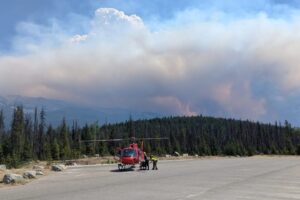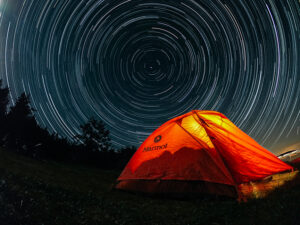A pair of protective, insulated boots is a foundational piece of your kit for frigid environments. That’s true whether you’re winter camping in the Rockies or exploring the polar regions.
Ice crystals can form on digits or feet with too much cold exposure, blocking blood flow and killing cells: Frostbite is no small injury. These health emergencies are extremely painful and require extensive healing time. Severe cases never recover. Plus, you’d never want to cut your trip short because of inadequate footwear.
Let’s avoid the risk, starting with a solid selection of warm winter boots. From polar exploration to ice fishing, snowshoeing, outside work, and everyday commutes, here are the warmest pairs to protect your feet.
Protective footwear: cold-weather tested
In our decades of exploring some of the coldest places on Earth, we’ve tested many pairs of boots in rugged terrain. If you want to learn more about the category, check out our detailed breakdown of important features at the end of the article.
But if you’re just shopping for a pair of warm winter boots that we know will work in freezing cold or arctic conditions, check out the product selections below. All of these will keep you warm, no matter how cold it gets.
Steger Mukluk Arctic With Ribbon, $220

Best For: Adventures in extreme cold, from ice fishing and dogsledding to arctic trekking to horseback riding and base camp
- Insulation: 9mm polypropylene lined wool felt liner
- Warmth Rating: -40° C
- Weight: 635gm (per boot)
- Shaft Height: 41 to 43+cm
- Pros: Excellent warmth, breathability, and light weight
- Cons: Not the most rugged tread design
- Sustainability Features: None
These Arctic With Ribbon boots from Steger Mukluk are the absolute classics for dry snow conditions. Mukluks are a soft footwear traditionally worn by the Inuit and Yupik of the Arctic. Often, the exterior is made of sealskin or reindeer skin and the interior is lined with fur. And Steger is owned by the former wife of polar explorer Will Steger. Our team uses this model on the coldest expeditions with total security.
In traditional fashion, this Steger pair is lightweight, comfortable, and cozy. It is far lighter than all the other polar models in this roundup — full one-third the weight of the Baffin Guide Pro, for example. It is the ideal choice for long-distance cold-weather trekking or snowshoeing.
The exterior moose hide is very durable and the canvas is weather-treated. Though the upper appears supple (and it is) the tread is aggressive, providing excellent traction across various snow surfaces. The natural rubber bottoms remain supple and never crack in the cold.
The boot cinches by way of a moosehide ribbon that wraps around the shaft. You don’t need this cinching to keep the foot secure in the boot, but it keeps snow out if you’re postholing through deep powder. Inside, a 9mm wool felt inner boot provides the warmth. Not only is there an option to upgrade to a wide boot — there’s also a double-wide option for the broadest feet. In fact, while standard models are fine for use around town or on day outings, the company rightly recommends ordering extra-wide and one size larger than normal for expedition use.
See the Steger Mukluk Arctic With Ribbon
Baffin Impact, $261

Best For: Hiking, casual use, and camp chores in arctic conditions
- Insulation: Removable multi-layer system including a PolyWool polyester wool blend
- Warmth Rating: -100° C
- Weight: 1683g (per boot)
- Shaft Height: 38cm
- Pros: Comfortable midsole, available in women’s specific
- Cons: A heavier choice
- Sustainability Features: None
Baffin is a Canadian footwear company based in Ontario with a huge foothold on cold-weather goods, including boots that support polar expeditionists like Eric Larsen.
The Impact boots have a reputation for ultra warmth, even while users sit idle at an ice-gleaming base camp in severe cold. Inside, the materials features an aluminum membrane that reflects and retains body heat in the boot. The waffle-comb footbed holds warm air, too, and another double layer of aluminum shields cold air from below. The system is top notch.
Hugging the feet is a soft, smooth proprietary material, called Thermaplush, that wicks away sweat — if your feet do happen to get hot during camp chores or other activities.
When walking across dicey ground, the outsole is waterproof and provides strong, confidence-providing grip. The midsole offers ample cushion and a bump of insulation. Two buckles help tighten up the boot and the snow collar with a sliding toggle helps prevent snow from sneaking its way inside. We also appreciate that they’re easy to pull on, thanks to the hardy pull loop.
Baffin Guide Pro II, $465

Best For: Ski expeditions, cross-country ski trips, and activities like hiking or ice fishing
- Insulation: Removable multi-layer system including a PolyNylon blend and gel-based insulation
- Warmth Rating: -70º C
- Weight: 1882g (per boot)
- Shaft Height: 44cm
- Pros: Tough toe piece is useful for icy, hardpacked terrain
- Cons: Not the quickest entry and exit
- Sustainability Features: None
If you plan on using skis, this pair of expedition boots fits the bill. The Baffin Guide Pro II has a reinforced steel toe piece that’s compatible with a three-pin binding for big mountain missions or cross-country ski tours. They’re toasty, too: Developed using nanotechnology, the removable liners feature a lightweight, gel-based thermal insulation.
An integrated gaiter with a Velcro closure surrounds the boot and the waterproof-breathable upper. Across the top of the talus, a buckled strap tightens the fit. Beneath the gaiter, the boot has a gusseted lace-up system. Up high, the collar has a snap and elastic closure to help block out the elements.
Thanks to the EVA midsole, there’s a comfortable cushion, which helps prevent fatigue (for a while). The outsole’s rubber and tread design delivers dependable grip across slick ground. For additional warmth, there’s a double aluminum insole, as in the Baffin Impact boot, that deflects cold back to the ground.
Overall, this pair’s stout toe is a game changer for more than skiing: It helps break trail, bootpack up slopes, and kick into icy hillsides.
Alfa Polar Advance, $910

Best For: Ski expeditions, ski tours, and ski races
- Insulation: Wool liner
- Warmth Rating: Unavailable
- Weight: 1070g (per boot)
- Shaft Height: 21cm
- Pros: Durable, timeless design
- Cons: Short shaft doesn’t offer the most protection in deep snow
- Sustainability Features: None
For expedition ski use in extremely frigid weather, these boots are old classics, and have a special reputation across Europe. The Mørdre brothers designed their prototypes years ago for an early Antarctic expedition.
The toe piece is the Vibram 75mm standard three-pin binding for clicking into skis. They also work with a cable binding. The shell is constructed with tenacious Cordura, a synthetic material blend that’s reinforced with leather and fiercely water repellent.
The upper’s full-grain leather is durable and breathable. The midsole’s rubber is built to not break or crack in cold temps. For a tailored fit, the traditional hook-and-lace system stretches from the toe to the cuff, allowing adjustability around the entire ankle and forefoot. Three exterior buckles bolster the laces and further secure the fit.
An important note: The brand recommends buying two sizes larger, so that you have room to add a thin nylon sock and a second vapor barrier sock. The vapor barrier sock (some use a bread bag or even a Ziploc) keeps foot moisture from accumulating as ice in the boot over the days and weeks.
Alfa Polar A/P/S Expedition Ski Boot, $955

Best For: Ski expeditions, covering long kilometres on skis in extreme cold
- Insulation: Felt
- Warmth Rating: Unavailable
- Weight: 995g (per boot)
- Shaft Height: 19.5cm
- Pros: Gaiters are made from Cordura, a tenacious, protective fabric
- Cons: Expensive
- Sustainability Features: None
Are you prepping to cross the Greenland or Norway’s Hardangervidda plateau on skis? The Alfa Polar A/P/S Expedition Ski Boot is durable for that trip and more. Though this boot is pricey, it will round out your kit with the right tool for a safe polar mission.
This robust but comfortable design keeps feet warm — but not hot — and dry even on blustery days with biting temps. The integrated durable Cordura gaiters shield the lower legs from the elements. The Rottefella outsole and felt insole both are loaded with hardy insulation. The insole is also anatomically-shaped for solid support, absorbs sweat yet is breathable, and features an antibacterial treatment to squelch odors.
The boots are compatible with the Rottefella NNN BC backcountry ski binding. This makes them mechanically more efficient than the Alfa Polar Advance boots, made for the old rat-trap bindings. A key note: The brand recommends buying two sizes larger, so that you have room to add a liner or wool inner boot and vapor barrier sock, for extreme conditions.
See the Alfa Polar A/P/S Expedition Ski Boot
ThirtyTwo Jones MTB, $659

Best For: Splitboard mountaineering, splitboard tours
- Insulation: Closed-cell foam
- Warmth Rating: Unavailable
- Weight: 1,500g (per boot)
- Shaft Height: 17.5cm
- Pros: Durable construction, features a walk mode collar for excellent range-of-motion on the ascent, available in women’s specific
- Cons: Too rigid for some riders, a tad heavy
- Sustainability Features: None
In partnership with Jeremy Jones, one of the most prolific big mountain freeride snowboarders in the sport’s history, ThirtyTwo released the ThirtyTwo Jones MTB boot, which is arguably the most rugged splitboard-specific boot ever made.
First off, the Jones MTB keeps your digits toasty thanks to the Elite Liner that’s constructed with Intuition foam, a closed-cell compound that’s durable and warm. The stout full-zip gaiters also block snow, ice, and wind, which helps to maintain the laces but also helps retain warmth. The Vibram rubber outsole helps to block cold and delivers traction.
Beyond warmth, the most favored feature in this design is the walk mode collar, which allows a wider range of motion for longer strides on ascents. The boot includes inserts to add stiffness, though you likely won’t need those right away. The stiffness rating is 10/10, the highest you can find. The rigidity is a drawback for some riders, especially if their feet don’t perfectly fit that stalwart mold.
La Sportiva Nepal Evo GTX, $525

Best For: Mountaineering missions with an emphasis on ice and supporting a loaded pack
- Insulation: GORE-TEX
- Warmth Rating: Unavailable
- Weight: 1012g (per boot)
- Shaft Height: Mid-calf
- Pros: Top-notch waterproofness and breathability
- Cons: A bit heavier-set
- Sustainability Features: Laces are made from recycled PET from plastic bottles
The Nepal boot series has thrived for more than three decades. The La Sportiva Nepal Evo GTX isn’t your go-to pair for simple hikes but is built for mountaineering pursuits and getting vertical on frozen waterfalls.
To block cold, the boot features GORE-TEX insulation, which boasts a 4-layer laminate. The combo includes a strong ePTFE (expanded polytetrafluoroethylene) membrane sandwiched with a material that retains warmth. Then there’s a durable, quick-drying textile liner and shell.
La Sportiva also adds the Ibi-Thermo footbed, with its insulating properties. The lateral flex is fair, and the boot is sturdy overall. For long-standing durability, the upper is made with 3.2mm premium Perwanger leather reinforced with silicone. A gaiter at the top of the boot helps block snow and debris and fits seamlessly with apparel.
See the La Sportiva Nepal Eno GTX
Scarpa Mont Blanc Pro GTX, $549

Best For: Ice climbing, alpine ascents, rugged work days like clearing trees
- Insulation: GORE-TEX
- Warmth Rating: Unavailable
- Weight: 900g (per boot)
- Shaft Height: Lower calf
- Pros: A bit lighter weight than competitor boots, comfortable, available in women’s specific
- Cons: The toebox is too narrow for some wider feet
- Sustainability Features: None
Whether you’re ice climbing or clearing trees from power lines, these precise-fitting boots will keep your feet glowing, far from an icebox, and supported.
The construction has out-of-box comfort and is a bit forgiving, making sidehilling easier and more nimble on an approach. The ankle is reinforced with a plastic web that’s injected into the elastic upper. The boot equally provides ample backbone for kicking crampon front points into a frozen waterfall.
The upper is a 3mm blend of Perwanger leather, suede, synthetic, and polyurethane. Underfoot, the Vibram outsole’s firm compound withstands and performs in super low temperatures.
Like the La Sportiva Nepal Evo GTX boots, this pair likewise features the GORE-TEX insulation 4-layer laminate for warmth. While belaying during a multi-pitch frozen waterfall climb in -23º C, we found the insulation worked extremely well and we never felt chilled feet.
See the Scarpa Mont Blanc Pro GTX
Kenetrek Mountain Extreme 1000, $505

Best For: Late-season hunts
- Insulation: 1000g Thinsulate
- Warmth Rating: Sub -18º C
- Weight: 1021g (per boot)
- Shaft Height: 25.4cm
- Pros: Stout, stable choice for low movement scenarios like hunting with bursts of high activity, available in women’s specific
- Cons: Not the lightest boot
- Sustainability Features: None
For tackling creek crossings in the wilderness or waiting for elk deep in the snow-covered pines, the Kenetrek Mountain Extreme 1000 boots are furiously waterproof and toasty.
The full-grain leather upper is treated with Windtex, a waterproof-breathable membrane that’s malleable and burly against the elements. Our feet stay extremely dry in these boots. The edge is reinforced with a rubber sole guard, and the 7mm nylon midsoles help brace a heavy load. Deep lugs on the tread of the lightweight outsole give excellent traction.
On the high-end of the scale, the Thinsulate insulation is rated at 1000 grams. So these super sturdy boots have kept our toes snug during moderate to low movement, like glassing for animals, even in temperatures below -18º C.
See the Kenetrek Mountain Extreme 1000
Vasque Breeze WT GTX, $200

Best For: Cold-weather hikes and snowshoe adventures with moderate to high output
- Insulation: 200g 3M Thinsulate
- Warmth Rating: Up to -32°C
- Weight: 647g (per boot)
- Shaft Height: Above the ankle
- Pros: Lightweight waterproof hiking boot, available in women’s specific
- Cons: Not the burliest option for low and moderate movement or extremely cold temperatures
- Sustainability Features: None
With virtually no break-in period, the all-season Breeze WT GTX is Vasque’s premium winter hiking boot in a comfortable off-the-shelf design that blocks water and cocoons heat.
The feet stay cozy thanks to 200 grams of 3M Thinsulate, a lightweight and very warm synthetic insulation. (The grams refers to the grams per square meter of insulation.) This quantity of insulation is on the lower-end to serve recreationists with more rigorous, ongoing movement. The result is a boot that’s free of bulk that feels bomber on an all-day mountain trek in -12°C plus windchill.
The midsole features an EVA cushion and a strong plastic shank for support and alleviation beneath the feet. Against mixed surfaces and snow, the outsole’s durable Vibram Megagrip compound grabs wet, muddy, slippery, and dry terrain. (That said, traction devices would likely be advised for steep or hardback slopes.)
In a well-balanced blend, the upper is constructed with GORE-TEX waterproof Nubuck leather and mesh, which helps the boot feel malleable and comfortable while providing a window for heat to be released while climbing to the top of a snowy 4,000m peak.
Muck Boot Company Arctic Sport Tall, $170

Best For: Work days, long drives, and casual around-town use
- Insulation: 5mm neoprene
- Warmth Rating: 4° to -40°C
- Weight: 1134g (per boot)
- Shaft Height: 42cm
- Pros: Prime choice for cold and wet conditions, women can check out the Muck Boot Company Arctic Ice Tall AGAT ($190)
- Cons: Not as warm as other boots in our guide
- Sustainability Features: None
While these are not as warm as some of the other boots listed here, they are good in everyday winter conditions, especially around wet snow. We use the Muck Boot Company Arctic Sport Tall boots when driving Zodiacs in the Arctic in freezing temperatures for hours upon hours. They’re the only boots that keep our feet warm in both cold and wet conditions. That heat is thanks to the 5-millimeter neoprene interior boot plus an additional 2-millimeter layer of thermal foam beneath the foot.
For additional comfort and warmth, the boot features a fleece liner that’s soft. The EVA midsole provides cushion and helps prevent foot fatigue. The shaft is wide to accommodate broad calves. The boot also provides plenty of traction with the robust outsole and tread pattern.
See the Muck Boot Company Arctic Sport Tall
Sorel Caribou, $170

Best For: Shoveling deep snow and commutes in frigid temperatures
- Insulation: 9mm recycled Felt
- Warmth Rating: -40°
- Weight: 1134g (per boot)
- Shaft Height: 22cm
- Pros: available in men’s specific
- Cons: Not a super streamlined or precise fit, especially for narrow-footed folks
- Sustainability Features: Recycled felt interior liner
When we step outside for a shoveling mission or a blustery walk in ice-cold degrees, this is one of the hardiest boots on our front door mat for everyday use. There’s a reason that this is one of the most classic winter boots on the planet.
The Sorel Caribou is built with a waterproof Nubuck leather upper that’s completely seam-sealed: water and snow just isn’t getting inside. The interior feels plush and protective with 9mm thick felt. The liner is topped off with a pile cuff to grab snowflakes and block wind if we’re quickly pulling these on with sweats or jeans to shovel the deck. Otherwise, snow pants with gaiters fit fine around the outside of the boot. The rubber outsole has fairly good traction, too.
Timberland Authentics Waterproof Roll-Top Boots, $165

Best For: Casual all-day style in slick conditions, ice-cold temperatures, and moderately deep snow
- Insulation: Faux fur
- Warmth Rating: Unavailable
- Weight: 624g (per boot)
- Shaft Height: 16.5cm
- Pros: Streamlined fit, men can check out the Timberland Richmond Ridge 6-Inch Waterproof Boots ($160)
- Cons: Relatively time-consuming to lace up
- Sustainability Features: Silver-rated eco-friendly Better Leather, ReBOTL material in the faux-fur collar and liner that’s made with recycled PET (polyethylene terephthalate) from plastic bottles
We’ve never received as many compliments on any other stout winter boot from guys and gals alike as we have on this pair. The Timberland Authentics Waterproof Roll-top Boots keeps our feet mighty happy in freezing temperatures and turbulent conditions.
To be honest, we’ve never worn this boot rolled down–we always pull the neck streamlined against our leg and tighten up all the laces for a guarded approach. One of the best aspects of this design is how well the shaft hugs the leg, which helps keep in warmth and prevents snow from sneaking into our tall socks.
The faux-fir liner is super soft and cozy. That waterproof upper blocks moisture from getting inside. An EVA foam footbed absorbs shock and a steel shank is integrated into the boot for support. We’re also a big fan of the hefty slip-resistant rubber outsole, muscular tread, and deep lugs–we don’t slide around in these boots.
We’d also like to give a nod to the brand for designing this boot with sustainable materials including recycled plastic in the faux-fur collar and liner and leather from a tannery that’s audited for environmentally sound practices.
See the Timberland Authentics Waterproof Roll-Top Boots
Vans Standard Snow MTE Boots, $160

Best For: Stylish and warm for casual use, snowshoeing, and professional meetings
- Insulation: Felt
- Warmth Rating: Unavailable
- Weight: Unavailable
- Shaft Height: Mid-calf
- Pros: Out-of-box comfort and super warm for low temps, available in women’s specific color options
- Cons: Not the most durable construction
- Sustainability Features: None
As a daily driver, the Vans Standard Snow MTE Boots keep our feet toasty while walking around town through deep snow or slush puddles, shoveling after a powder storm, and snowshoeing, too.
The waterproof upper is made with a blend of synthetic leather and rubber. The interior felt liner is removable for easy dry out. Simply put, they look good and are very warm. The tread is also nice and grippy.
See the Vans Standard Snow MTE Boots
Blundstone Thermal Chelsea Boots, $239

Best For: Efficient on-and-off boots with universal style and function from framework to dinner or shoveling the deck
- Insulation: Thinsulate
- Warmth Rating: Unavailable
- Weight: 510g
- Shaft Height: Ankle-high boots
- Pros: Lightweight and quick to slip on, available in women’s specific
- Cons: Not the tallest shaft or most protective boot for deep snow
- Sustainability Features: None
The Blundstone Thermal Chelsea Boots is one of our all-time favorite everyday winter boots because of the ease of pulling them on and off, high warmth factor, and sturdy support beneath our feet. This low-profile design is also relatively lightweight. Blundstone Footwear is a legacy Australian footwear brand that specializes in lace-free utilitarian boots originally made for cobbled streets and rough farmland work. More recently, these boots have become popular in snowy mountain towns.
We pull the insulated Chelsea on for everyday use, travel, walking and riding our bike around town, and days at the farm. They’re a great option for sliding out of snowboard or ski boots at the ski base area, pulling off wet booties after frigid winter surfing, or after a cold winter mountain bike or fat bike ride.
Inside, the removable sheepskin footbed provides warmth and comfort–and ours has only begun to wear out after three 8-month winters of nearly everyday use. The upper is made with premium waterproof leather, which is free of eyelets and any chance of moisture leaking inside. The seams are made with waterproof elastic.
The durable outsole is constructed with slip-free thermoplastic polyurethane (TPU) and moderate lugs for walking on variable surfaces. To help prevent fatigue with long days on foot, the patented ergonomic midsole is designed for shock absorption and extra comfort in the heel and toe area.
See the Blundstone Thermal Chelsea Boots
How to choose cold-weather boots
Before you buy a pair of winter boots for cold conditions, consider how you plan to use the boots. Are they for everyday use cruising around town and shoveling the driveway? Is this a work boot for days in agriculture or construction? Or are you planning a specific expedition for ice climbing or a ski traverse? We have all of our favorite options across those categories lined up here.
When in doubt about whether a model is truly one of the warmest winter boots on the planet, consider these features:
Types of winter and cold-weather boots
There is a wide variety of winter boots. On one end, our closet has a few pragmatic, comfortable pairs for everyday errands, outdoor work, and travel. Then, we have a lineup of sport-tailored designs for everything from ice climbing to mountaineering, winter hikes, and long-distance, multi-day ski traverses.
Each boot design provides a unique fit that’s either more roomy or precise. Some boots are more simple, utilitarian, and easy to pull on. Others are far more technical and usually more complicated to close up for an extreme adventure.
Shaft height
The shaft height protects your body, socks, and base layers from getting wet from snow infiltration. Also, the taller a boot is, the warmer it can feel, because it’s encapsulating additional body heat from the ankle up.
If we’re playing outside in deep powder, or digging our rig out of a huge snow storm, we love a tall boot like the Steger Mukluk Arctic With Ribbon. The Steger reaches the highest of any boot, up to 43cm high. Their warmth and lightness makes them one of the boots of choice for long-distance manhauling expeditions with Berwin-type ski bindings. But their softness and comfort comes with a drawback: no lateral support for even gentle downhills. They excel at shuffling on the flats.
For some high-aerobic activities, like snowshoeing, or other movement on packed snow, a shorter shaft height provides adequate warmth, more breathability, and more maneuverability. For instance, the Blundstone Thermal Chelsea Boots are ankle high, and the Vasque Breeze WT GTX reaches a tad higher, above the ankle.
Insulation
One common type of insulation you’ll see in several of our select boots is made by 3M Thinsulate. The quantity of Thinsulate insulation in a boot is referred to by the grams per square metre of insulation, which can commonly range from 200 grams to 1000 grams. For instance, the Vasque Breeze WT GTX has 200 grams of Thinsulate, and the Blundstone Thermal Chelsea Boots also has Thinsulate.
On the warmest side, the Kenetrek Mountain Extreme 1000 has 1000 grams of Thinsulate insulation, which is ideal for low to moderate movement like posting up in the woods to glass for elk during a late-season hunt. On the other hand, 200 grams of Thinsulate insulation is a good fit for activities that are more rigorous, aerobic with consistent movement that builds heat: You don’t want to be sweating up a storm on your snowshoe tour.
Other dependable forms of insulation in our top-choice winter boots here include GORE-TEX, closed-cell foam, wool and wool blends, felt, recycled felt, and neoprene, which offers resistance against wet, sloppy, and cold conditions.
Generally, you’ll see a price uptick in insulation technology that is both warmer and lighter weight, which is key when you need a streamlined boot for activities like alpine or ice climbing and mountaineering.
Boot closure
The type of boot closure is key for usability and function. The ideal choice mostly depends on how you will use the boot, as well as your personal preference.
Among our favorite cold-weather boots, the Muck Boot Company Arctic Sport Tall and the Blundstone Thermal Chelsea Boots are the easiest boots to pull on, given they are slip-on designs that are lace-free. If you find yourself running in and out of your house throughout the day, these could be a good choice.
The Baffin Impact is a unique slip-on design with buckles for reinforcement. And the Steger Mukluk Arctic With Ribbon features a traditional ribbon that wraps around the shaft.
On the other hand, the Sorel Caribou closes up via traditional laces yet is easy to slip on and off due to the relatively minimal amount of lace and the wideness of the shaft. Comparatively, you’ll notice that the Kenetrek Mountain Extreme 1000 laces are finer for greater tuning and stretch further up the shaft and lower toward the toe box. The laces are likewise tighter on the See the Timberland Authentics Waterproof Roll-Top Boots, and therefore require more time to lace up. But the user experience is more sturdy, well-fitted, and protective.
A handful of boots also have a wrap-around gaiter to protect the interior lace system. These models include the Baffin Guide Pro II and the Alfa Polar A/P/S Expedition Ski Boot or the ThirtyTwo Jones MTB.
Weight
In our perspective, the grams of each pair of our favorite boots is fair, essential, and worth the carry. The reason why goes back to the application of the boot. If we are climbing a frozen waterfall or traversing the Arctic on skis, we’d expect the boot to provide adequate protection for that activity and environment. Equally, such a boot would generally be overbuilt for everyday use, even in blizzard conditions. Regardless, none of these boots are built with lead or make our hips feels like they’re going to fall off.
To give you an idea of the weight for protective winter boots, the lightest pairs range from 500 to 700 grams per boot and are good for casual, utilitarian applications and hikes. That includes the Blundstone Thermal Chelsea Boots, which are 510 grams, as well as the Timberland Authentics Waterproof Roll-Top Boots at 624 grams, and the 647-gram Vasque Breeze WT GTX.
On the slightly heavier side, the Sorel Caribou and Muck Boot Company Arctic Sport Tall are both 1134 grams. On the heaviest end of the spectrum, the ThirtyTwo Jones MTB is 1,500 grams and the Baffin Guide Pro II is 1882 grams. Again, during mountaineering pursuits, we find that higher weight is appropriate for the overall protection that’s delivered.
Outsoles and tread
The outsole and tread of these winter boots are important for several reasons. First, the type of material used to create the outsole is made for specific temperature ranges and terrain from ice to snow or rock and mixed coverage. Otherwise, the material can break down faster in colder or rougher conditions or more aggressive use patterns like kicking into ice. An outsole’s material also provides a particular grip on slick icy surfaces.
The depth, size, and pattern of the lugs is made for particular conditions, as is the heel and toe design. The height and material also offers a barrier against cold temperatures of the snow or ice beneath.
Some boots are developed with an outsole that easily and safely accommodates crampons for mountaineering, including the ThirtyTwo Jones MTB and the Scarpa Mont Blanc Pro GTX. Likewise, other boots are built to click into ski bindings like the Baffin Guide Pro II or Alfa Polar Advance, or Alfa Polar A/P/S Expedition Ski Boot. We’ve found that the boots we’ve selected here all have sound, sturdy outsoles and tread for their given use.
Sustainability features
A handful of these winter boots have components of sustainable design while many have none. For the longevity of the planet and human exploration, it’s essential for brands worldwide to prioritize high-level product design that also pushes the needle forward on environmentally-friendly materials, fabric treatments, sourcing, and manufacturing solutions that are less toxic for people and the earth.
A few sustainable design features in these warm winter boots include recycled felt interior liners and eco-friendly leather. Specifically, Timberland partners with the Leather Working Group, a multi-stakeholder auditing organization, to rate the environmental friendliness of the leather that is sourced for their footwear. The pair we include here, the Authentics Waterproof Roll-Top Boots, is silver-rated: The classification is based on the responsible energy use, waste management, and water treatment at the tannery.
Another sustainable material used in winter boots is called ReBOTL, which includes at least 50% recycled PET (polyethylene terephthalate) sourced from plastic bottles.

The author ice climbs in a pair of Scarpa Mont Blancs. Photo: Xander Bianchi
Price
Generally you’ll find two price ranges among the warmest winter boots for cold weather. Nearly half of our favorite boots here cost from $160 to $260. This camp of boots is usually less technical or sport-specific and a tad less burly or tall, but these designs offer great protection against cold temperatures and are comfortable. Boots in this price range are usually great for everyday use, snowshoeing, and work days. A couple of options include the Blundstone Thermal Chelsea Boots and Timberland Authentics Waterproof Roll-Top Boots.
Our second tier of winter boots has a cost hike: $465 to $585, according to our top picks. These boots are even more superior at providing thermo-regulation and warmth in freezing conditions and in low-to-moderate movement. You’ll find more sport specific options like the ThirtyTwo Jones MTB for splitboard mountaineering and snowboarding, and the Kenetrek Mountain Extreme 1000 for late-season hunters or the Scarpa Mont Blanc Pro GTX for ice climbing and tree climbing on work days.
Occasionally, you’ll see extremely built-out, sport-specific footwear for arctic exploration like the very expensive Alfa Polar A/P/S Expedition Ski Boot at $955–but what you pay for is what you get. Don’t skimp on footwear if the protection is a necessity for the environment where you plan to go.
A note on socks
Be sure to pull on dry and appropriately cushioned socks for your outdoor adventures. Well-constructed hosiery makes a big different with moisture management, warmth, and comfort. We tend to prefer socks that are a synthetic wool blend: Wool is a great insulator and also naturally fights odors.






